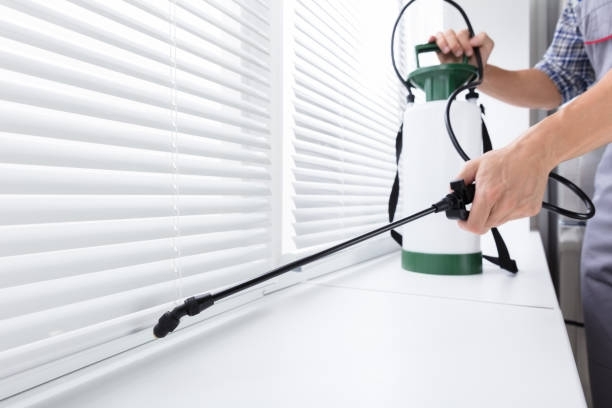When pests find their way into your home, the problem often starts with small openings you may not notice. Tiny cracks, gaps, and unsealed utility lines can serve as welcome mats for ants, spiders, cockroaches, and rodents. These access points are more common than many homeowners realize, and without a proper plan to identify and seal them, infestations can become a recurring issue.
Effective pest control begins with understanding how and where pests are getting inside. Once entry points are identified, targeted sealing can dramatically reduce the likelihood of indoor infestations. This approach also supports broader prevention strategies, such as maintaining a clean kitchen to discourage ants and reducing clutter to limit spider hiding spots.

Door and Window Gaps
Doors and windows are among the most common pest entry points. Even a small gap under a door or a torn window screen can be an open invitation for insects and rodents.
- Worn weather stripping: Over time, weather stripping can crack, shrink, or detach, leaving enough space for pests to enter. This is a frequent issue in homes exposed to seasonal temperature changes, which can cause materials to expand and contract.
- Damaged screens: Tears in window or vent screens allow flying insects direct access to your home. Mosquitoes, flies, and even small spiders can exploit these openings.
- Loose frames: Poorly fitted frames can create small openings along edges and corners that pests can slip through unnoticed.
Inspect doors and windows at least twice a year and after severe weather events. Replacing weather stripping, repairing screens, and adding door sweeps can block many pests before they get a chance to step inside.
Utility and Plumbing Openings
Pests are opportunistic and will use any gap around utility lines or pipes to get inside. These entry points often go unnoticed because they are hidden behind appliances or in basements, attics, and crawl spaces.
- Cable and conduit holes: Gaps where electrical or internet lines enter the home should be sealed with durable caulk, foam sealant, or pest-proof mesh.
- Plumbing penetrations: Spaces around pipes under sinks, behind toilets, and near washing machines can be large enough for insects and rodents to enter freely.
- HVAC and dryer vents: Improperly sealed or damaged vents not only let pests in but can also become nesting sites for insects and small animals.
Addressing these openings is especially important for preventing ants in kitchen areas, as discussed in tips for an ant-free kitchen. Even a small gap behind a dishwasher or refrigerator can become a major access point if ignored.
Foundation and Exterior Wall Cracks
The foundation and exterior walls form your home’s main protective barrier, but time, weather, and settling can create vulnerabilities. Even hairline cracks can widen over time, allowing entry for pests.
- Settling cracks: Natural settling of the home can create small fissures that ants and spiders can use to enter.
- Brick and mortar damage: Crumbling mortar or loose bricks provide direct pathways indoors. Termites and ants in particular can exploit these weaknesses to gain access to structural wood.
- Siding gaps: Warped, cracked, or improperly installed siding can expose underlying materials and create entry points.
Foundation and wall inspections should be part of regular home maintenance. Using high-quality mortar, sealant, or weather-resistant fillers can close gaps and strengthen your property’s perimeter against pests.
Roof and Attic Access Points
Rooflines, attic vents, and eaves can be overlooked when checking for pest entry points. Yet these elevated areas are favored by certain insects and even small animals because they often remain undisturbed.
- Damaged soffits and fascia: Deterioration in these components can leave enough space for pests to slip through, especially wasps and spiders.
- Unscreened vents: Attic or gable vents without fine mesh screens invite flying insects and provide ideal entry points.
- Loose shingles or flashing: Water damage or wind can loosen roofing materials, opening concealed pathways for pests.
Since some spiders prefer dark, elevated spaces, an unsealed attic can provide ideal shelter. Identifying these areas ties directly into understanding spider hiding spots, which helps in preventing infestations before they spread.
Garage and Basement Entryways
Garages and basements often have large doors, vents, and utility access points that make them especially vulnerable. Once pests enter these areas, it’s easier for them to spread into living spaces.
- Gaps under garage doors: Misaligned or worn seals can allow crawling pests like ants, cockroaches, and even small rodents to slip through.
- Ventilation openings: Basements often have vents that may lose their protective covers over time, creating easy access.
- Storage areas: Stacked boxes and clutter near doors can hide cracks and holes, making them hard to detect during routine checks.
Keeping these entryways secure not only limits pest access but also strengthens your home’s overall protection. Adding heavy-duty rubber seals to garage doors and screening ventilation openings can go a long way in reducing pest entry.
Why Sealing Entry Points Works Best with Comprehensive Prevention
While sealing gaps is a powerful step in pest control, it should be part of a larger prevention strategy. Reducing attractants, maintaining cleanliness, and scheduling periodic inspections help ensure pests stay outside. Sealing entry points eliminates immediate access, but without addressing food, water, and shelter sources, pests may continue to seek ways inside.
Regular inspections are crucial for catching new vulnerabilities early. Seasonal changes, home renovations, and weather damage can all create fresh openings. Pairing entry-point sealing with other preventive measures builds a layered defense that keeps pest activity under control year-round.
Seal the Gaps, Stop the Pests
Every small opening in your home is a potential entry point for pests, and sealing them is a critical step in prevention. For professional inspection and expert sealing solutions, contact Fisher’s Pest Control and keep your home protected year-round.





